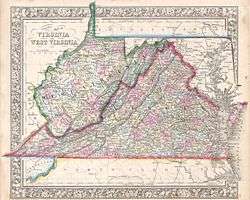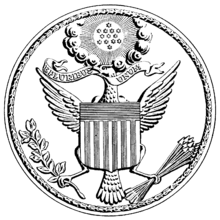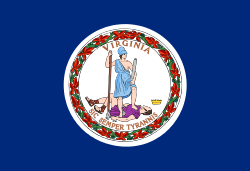Restored Government of Virginia
| Restored Government of Virginia | ||||||
| Restored state government of United States of America | ||||||
| ||||||
| ||||||
 | ||||||
| Capital | | |||||
| Government | Organized incorporated state | |||||
| Governor | ||||||
| • | 1861–1865 | Francis Harrison Pierpont | ||||
| Historical era | American Civil War | |||||
| • | Second Wheeling Convention | June 11, 1861 | ||||
| • | Formation of a new state government | June 19, 1861 | ||||
| • | West Virginia admitted to the Union | June 20, 1863 | ||||
| • | Surrender of the Confederacy | April 9, 1865 | ||||
| • | Provisional government formed in Richmond | May 9, 1865 | ||||
 |
|
Union states in the American Civil War |
|---|
|
|
| Border states |
| Dual governments |
| Territories and D.C. |
The Restored Government of Virginia, also known as the Reorganized Government of Virginia, was the Unionist government of Virginia during the American Civil War. From 1861 until mid-1863 it met in Wheeling, and from August 26, 1863 until June 1865 it met in Alexandria. The Restored Government claimed Richmond as its official capital from its formation and it moved there after the city returned to Union control.
The Restored Government had only executive and legislative branches; it did not form a judicial branch.
Formation
When the Second Wheeling Convention met in its first session, in June 1861, it adopted "A Declaration of the People of Virginia".[1] The declaration stated that the Virginia Declaration of Rights required any substantial change in the form or nature of state government to be approved by the people. Since the Virginia secession convention had been convened by the legislature, not the people, the declaration pronounced the secession convention illegal, and that all of its acts—including the Ordinance of Secession—were ipso facto void. It also declared the pro-secession government void and called for a reorganization of the state government, taking the line that all state officials who had acceded to the Ordinance of Secession had effectively vacated their offices. The members and officers of the Restored Government had themselves not been elected by the people to the offices they had assumed, but instead convened on the basis of local petition and other irregular accreditation, some "more or less self-appointed".[2]
The convention then elected Francis Harrison Pierpont as governor, along with other executive officers, with Wheeling as the provisional state capital. President Abraham Lincoln recognized the Restored Government as the legitimate government of the entire Commonwealth of Virginia.[3] The United States Congress seated the two new United States senators chosen by its legislature, and five U.S. representatives elected from the territories that remained loyal to the Union. Its Congressional delegation in the 37th United States Congress entirely made up of Unconditional Unionists. U.S. Senators elected were Waitman T. Willey and John S. Carlile. Representatives were seated from where delegates in the Richmond Convention of 1861 had voted to remain in the Union. They were the western 10th, William G. Brown, the 11th, Jacob B. Blair, and 12th, Kellian V. Whaley, in Congressional Districts of counties that would mostly become West Virginia, along with the 7th, Charles H. Upton, from Alexandria and Fairfax County, and the 1st, Joseph E. Segar in the Eastern Shore and Tidewater Peninsulas. Following the loss of its governance over the population of West Virginia, Congress in the 38th United States Congress did not seat either Senators elected by the Restored General Assembly, nor Representatives elected in truncated elections in Union occupied areas of Virginia; the entire state's delegation went vacant.[4]
By the end of 1861 large Confederate forces had abandoned western Virginia, but small brigades of Confederate soldiers commanded by William Lowther Jackson and Albert G. Jenkins operated throughout the area during the war. The Restored Government attempted to exercise de facto authority, at least over the western counties, but had control of no more than half of the fifty counties that became West Virginia.[5] On August 22, 1862, the Restored Government's Adjutant General, Henry I. Samuels, reported to Gov. Pierpont that there were 22 counties in which they could raise Union volunteers, but "...in several of the Counties I have named, a draft would be an operation of extreme difficulty..."[6]
Government in Wheeling
A movement for separate statehood had grown in the trans-Allegheny region of Virginia long before the outbreak of war. A key obstacle to separate admission to the Union was that the United States Constitution forbade the creation of new states out of existing ones without the consent of the existing state's legislature. Soon after the president and Congress recognized the Restored Government as the legitimate government of Virginia, it asserted its authority to give such consent. The legislature that met between the two sessions of the Wheeling Convention in 1861 failed to pass a statehood bill,[7] but the second session of the convention approved it. A popular referendum in October 1861 was called on the creation of the new "State of Kanawha" from the counties of northwestern Virginia. The voters' approval led to a constitutional convention, and another popular vote in April 1862 approving the new constitution of the now renamed "West Virginia".[8] The U.S. Congress then passed a statehood bill for West Virginia, but with the added condition that slaves be emancipated in the new state, and that certain disputed counties be excluded.[9] Lincoln, though reluctant to divide Virginia during a war aimed at re-uniting the country, signed the statehood bill into law on December 31, 1862.[10] In Wheeling, the added conditions required another constitutional convention and popular referendum. Statehood was achieved on June 20, 1863.
Government in Alexandria
Following West Virginia statehood, the Restored Government of Virginia relinquished authority over the counties of the new state, and thus lost most of its area not under Confederate control. Pierpont then moved the Restored Government to Alexandria, effective August 26, 1863. Located in Virginia proper, across the Potomac River from Washington, D.C., the city of Alexandria remained under Union control for the entirety of the war. The Restored Government claimed legitimacy over all of Virginia not incorporated into West Virginia. Rather than recognize the Confederate state government in Richmond, Pierpont had characterized it as "large numbers of evil-minded persons [that] have banded together in military organizations with intent to overthrow the Government of the State; and for that purpose have called to their aid like-minded persons from other States, who, in pursuance of such call, have invaded this Commonwealth."[3] But outside the few jurisdictions Pierpont's government held under federal arms, control of the state was in Richmond, for instance, in collecting taxes. Several localities sent representatives to both the Alexandria and Richmond legislatures.[11]
The Restored Government adopted a new Virginia constitution in 1864 that recognized the creation of West Virginia, abolished slavery, and disqualified supporters of the southern Confederacy from voting. The constitution was effective only in the Union-controlled areas of Virginia: several northern Virginia counties, the Norfolk area, and the Eastern Shore.[12]
Government moves to Richmond
After the fall of Richmond and the end of the Civil War in May 1865, the executive officers moved the government from Alexandria to Richmond, which the Restored Government had always considered to be its official capital. The government operating under the Constitution of 1864 thereafter assumed civil authority for the entire Commonwealth of Virginia, until adoption of the Constitution of 1869. Some West Virginians expressed concern that once restored to the Union the government of Virginia might seek to challenge the validity of the authority the Restored Government possessed in consenting to West Virginia's admission to the Union. To alleviate these concerns, the Congress set as a condition for Virginia's readmission to Congress that it affirm in its 1869 Constitution that the authority by which the State of West Virginia was created out of Virginia territory had indeed been valid, thus giving its consent to the creation of West Virginia retroactively to 1863.
Officers of the Restored Government
Governor
- Francis Harrison Pierpont (1861–1865)
Lieutenant Governors
- Daniel Polsley (1861–1863)
- Leopold Copeland Parker Cowper (1863–1865)
Attorneys General
- James S. Wheat (1861–1863)
- Thomas Russell Bowden (1863–1865)
References
- ↑ "Declaration of the People of Virginia Represented in Convention at Wheeling". Wheeling, Virginia. June 13, 1861. Retrieved January 30, 2015.
- ↑ Ambler, Charles H. and Festus P. Summers, West Virginia, the Mountain State, Prentice-Hall, Inc., 1958, pg. 200
- 1 2 "VIRGINIA.; The Restored Government of Virginia—History of the New State of Things". The New York Times. June 26, 1864.
- ↑ Martis, Kenneth. Historical Atlas of the United States Congress, 1789–1989. 1989, ISBN 978-0-0292-0170-1, p. 114-116
- ↑ Curry, Richard Orr, A House Divided, Statehood Politics & the Copperhead Movement in West Virginia, Univ. of Pittsburgh Press, 1964, pg. 8
- ↑ Ambler, Charles, Francis H. Pierpont: Union War Governor of Virginia and Father of West Virginia, Univ. of North Carolina, 1937, pg. 419, note 36
- ↑ "Legislature of the Reorganized Government of Virginia: Extra Session". www.wvculture.org. Retrieved 2016-09-29.
- ↑ http://www.wvculture.org/hiStory/statehood/statehood11.html
- ↑ http://www.encyclopediavirginia.org/West_Virginia_Creation_of
- ↑ "Lincoln's Dilemma". www.wvculture.org. Retrieved 2016-09-29.
- ↑ Hamilton James Eckenrode, The political history of Virginia during the Reconstruction, Issue 1.
- ↑ http://www.encyclopediavirginia.org/Virginia_Convention_of_1864
Further reading
- Ambler, Charles H. Francis H. Pierpont: Union War Governor and Father of West Virginia (1937), the standard scholarly biography
- Ambler, Charles H. and Festus P. Summers. West Virginia, the Mountain State (2nd ed. 1958) pp 202-6 online
External links
- "A State of Convenience: The Creation of West Virginia". West Virginia Division of Culture and History. Retrieved 2010-05-06.
- "Virginia Convention of 1864". Encyclopedia Virginia. Retrieved 2011-03-23.
- West Virginia statehood at West Virginia Archives and History

.png)